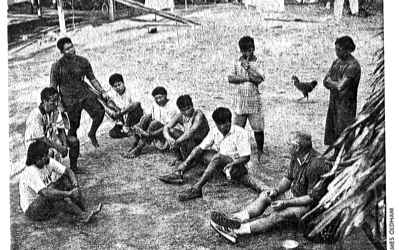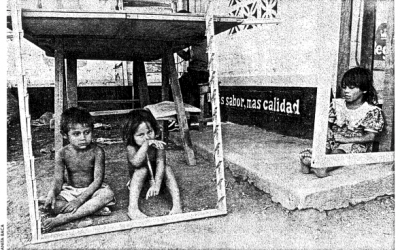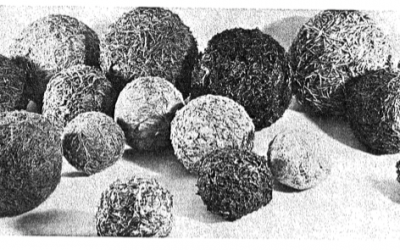The Environment
First Hand and Bi-national

Drawing by Patrick Alvarado, 8, of Mexico City, son of 1997-98 DRCLAS Visiting Scholar Arturo Alvarado and Barbara Driscoll
In planning my schedule for the weeks of research I spent on the U.S.-Mexican border this summer, I knew I would have to factor traffic into my plans. This was certainly on my mind as I began to set up appointments in sister cities along the border for the summer to study the roles of two bi-national institutions that have been able to play in alleviating environmental problems in the border region.
There may be less of a theoretical border with the creation of NAFTA’s bi-national institutions, the subject of my research this summer, but the endless lines of cars constantly reminded me of the physical reality of the border crossing, a noxious mix of carbon dioxide and beeping horns. After my first full day of work in Ciudad Juarez, I prepared to cross to the El Paso side at 8 p.m. I feared the worst and began to mentally prepare myself for sitting on the bridge over the Rio Grande for at least an hour. But as I turned off the highway and towards the bridge, I saw no line of cars unfolding before me. I passed through customs in under five minutes and merely had to smile and reply “US” when asked my citizenship before I was waved across to the US side. Shocked, I was sure it was a fluke.
The next day I prepared myself for the border crossing. I left Juarez an hour and a half before my 3:00 meeting in El Paso. I ended up spending an hour in the International Boundary and Water Commission office waiting for the appointed hour to arrive. By now, after only two days in El Paso/Juarez, I was sure I had the system figured out: clearly, as long as one did not travel at rush hour, one would have no difficulties entering the US. I began to put this theory into action. My third day of research I called my host family in El Paso and told them I would be home by 8:30 for dinner. I left the office at eight and sat for almost two hours on the bridge in the dreaded traffic I had heard so much about. The customs officer even asked me to step out of my car and searched it thoroughly. I didn’t get home until 10:30; a dinner of cold lasagna was waiting for me in the fridge and much of my host family was already asleep. I considered myself lucky that the only repercussion of my first encounter with the endless lines of cars was a cold dinner as opposed to a missed meeting. I never allowed less than an hour for a border crossing after that night.
Fall 1998
Erica Simmons is a senior in the Social Studies department and a candidate for a certificate in Latin American Studies. Funded by a DRCLAS travel grant, she spent her summer traveling along the U.S.-Mexican border and to Mexico City in order to do research for her senior thesis. Erica studied the roles that the Border Environment Cooperation Commission and the North American Development Bank, two bi-national institutions resulting from parallel agreement to NAFTA, have been able to play in alleviating environmental problems in the border region. Created in a highly politicized environment, the institutions are attempting to aid border communities in much-needed environmental infrastructure development. Erica is interested in understanding the impact these institutions can have on the border and in the way the US and Mexico relate on environmental issues.
Related Articles
Environment, Indians, and Oil
An Indian leader from the Upper Amazon recently commented to me that the whole issue of the environment, Indians, and oil companies had taken on global mythical proportions. He was partly…
El Salvador Challenge
Over the past few years, El Salvador has accomplished what can only be described as a political and economic miracle. Peace accords were concluded, ending a decade-long destructive civil…
Ecology, Art, and Home
Growing up in the Argentine Pampas gave me a great appreciation for even the simplest materials. As a little girl, I would sit in the dirt of the sun-scorched patio and admire the plain dirt…




